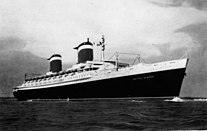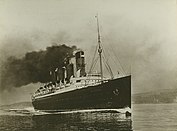
Back Modrá stuha Czech Blå bånd (Nordatlanten) Danish Blaues Band German Blua vimplo Esperanto Banda Azul Spanish Sinine Lint Estonian Ruban bleu French Blauwe Wimpel Frisian הסרט הכחול HE Kék Szalag Hungarian
The Blue Riband (/ˈrɪbənd/) is an unofficial accolade given to the passenger liner crossing the Atlantic Ocean in regular service with the record highest average speed. The term was borrowed from horse racing and was not widely used until after 1910.[1][2] The record is based on average speed rather than passage time because ships follow different routes.[3] Also, eastbound and westbound speed records are reckoned separately, as the more difficult westbound record voyage, against the Gulf Stream and the prevailing weather systems, typically results in lower average speeds.[4][Note 1]
Of the 35 Atlantic liners to hold the Blue Riband, 25 were British, followed by five German, three American, as well as one each from Italy and France. Thirteen were Cunarders (plus Queen Mary of Cunard White Star), five by White Star, with four owned by Norddeutscher Lloyd, two by Collins, two by Inman and two by Guion, and one each by British American, Great Western, Hamburg-America, the Italian Line, Compagnie Générale Transatlantique and finally the United States Lines.[1] The record set by United States in 1952 remains unbroken by any passenger liner. The next-longest period through which the Blue Riband was retained was 19 years, held from 1909 to 1929 by Mauretania. The shortest period was six weeks, by Bremen from July to August 1933.
Many of these ships were built with substantial government subsidies and were designed with military considerations in mind.[3] Winston Churchill estimated that the two Cunard Queens helped shorten the Second World War by a year.[5] The last Atlantic liner to hold the Blue Riband, the SS United States, was designed for her potential use as a troopship as well as her service as a commercial passenger liner.[3] There was no formal award until 1935, when Harold K. Hales donated the Hales Trophy; though the rules for the Hales Trophy were different from the traditional rules for the Blue Riband (for example, the Hales Trophy was originally only awarded for westbound records[6]) and changed several times thereafter. It was awarded to just three Blue Riband holders during the express liner era. The trophy continues to be awarded, though many people believe United States remains as the holder of the Blue Riband,[7] because no subsequent record-breaker was in Atlantic passenger service.
- ^ a b Kludas, Arnold (2000). Record Breakers of the North Atlantic, Blue Riband Liners 1838–1952. London: Chatham. ISBN 1-86176-141-4.[page needed]
- ^ Fox, Stephen (2003). Transatlantic: Samuel Cunard, Isambard Brunel and the Great Atlantic Steamships. New York: HarperCollins. ISBN 0-06-019595-9.[page needed]
- ^ a b c Gibbs, Charles Robert Vernon (1957). Passenger Liners of the Western Ocean: A Record of Atlantic Steam and Motor Passenger Vessels from 1838 to the Present Day. London: Staples Press. OCLC 225962096.[page needed]
- ^ Bonsor, Noel (1980). North Atlantic Seaway: An Illustrated History of the Passenger Services Linking the Old World with the New. Vol. 5. Cambridge: Brookside Publications. pp. 1866–71. ISBN 0-905824-04-0.
- ^ Cite error: The named reference
grahamwas invoked but never defined (see the help page). - ^ Kludas (2000), p. 17.
- ^ Kludas (2000), p. 136
Cite error: There are <ref group=Note> tags on this page, but the references will not show without a {{reflist|group=Note}} template (see the help page).

